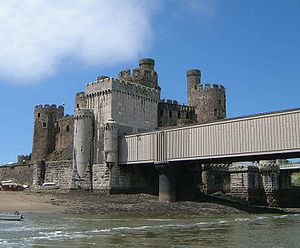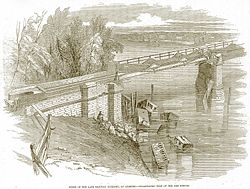- Chester and Holyhead Railway
-
"Irish Mail" redirects here. For Ireland's national postal service, see An Post. For the Irish newspaper, see Irish Daily Mail.
North Wales Coast Line Legend


To Dublin and Dún Laoghaire 


Holyhead 


Valley 


Rhosneigr 


Ty Croes 


Bodorgan 


to Amlwch 


Gaerwen 


Llanfair PG 


Britannia Bridge - Menai Strait 




to Afon Wen 


Menai Bridge 


Bangor 




to Bethesda 




to Port Penrhyn 


Aber 


Llanfairfechan 


Penmaenmawr 


Conwy 


Conwy railway bridge - River Conwy 


Llandudno 


Deganwy 





Llandudno Junction 




Conwy Valley Line 


Mochdre 


Colwyn Bay 


Abergele & Pensarn 




to Denbigh and Corwen 


Rhyl 




to Dyserth 


Prestatyn 


Talacre 


Mostyn 


Holywell Junction 




former Holywell Branch Line 


Bagillt 


Flint 


Connahs Quay 




Shotton Borderlands 


Queensferry 


Sandycroft 




Mold Junction 




Shrewsbury to Chester Line 


Roodee Viaduct, River Dee 


Wirral Line 


Chester 


Chester-Manchester Line 




Mid-Cheshire Line 


Waverton 




Whitchurch and Tattenhall Railway 


Tattenhall Road 


Beeston Castle and Tarporley 


Calveley 


Worleston 




West Coast Main Line 




Crewe-Manchester Line 




Crewe 




Crewe-Derby Line 




Welsh Marches Line 


West Coast Main Line
The Chester and Holyhead Railway was incorporated out of a proposal to link Holyhead, the traditional port for the Irish Mail, with London by way of the existing Chester and Crewe Railway, and what is now the West Coast Main Line. Indeed the carriage of the Irish Mail was always the primary objective of the founding Directors.Contents
The Irish Mail
When Queen Elizabeth I decided to establish a weekly post to Ireland in 1572, the route via Chester and Liverpool was chosen, before being switched four years later to Holyhead, which represented a shorter sea crossing.
The weekly post was sufficient when there was an English or British Parliament in London and an Irish Parliament, with urgent messages carried by civil servants, usually on horseback. The post improved slowly, and by 1784 the Turnpike Acts had resulted in improved roads on which a mail coach operated almost daily from London to Holyhead, taking 45 hours to make the journey.
With the passing of the Act of Union in 1800, creating the United Kingdom of Great Britain and Ireland, elected Irish members of the new United Kingdom Parliament sought the same quality of travel and postal facilities as their fellow members from England, Wales and Scotland. Improvements continued slowly, and by the time Thomas Telford had completed his A5 road with improvements through Shrewsbury, Llangollen, Betws-y-coed, Bangor and his Menai Suspension Bridge in 1826, the London to Holyhead journey was down to under 30 hours. The first steam packet boats had entered service between Holyhead and Dublin in 1819 and soon they were operating out of Liverpool as well.
With the coming of the railways, the Liverpool and Manchester Railway, the London and Birmingham Railway and their combination to form the Grand Junction Railway, there were fast trains from London to Liverpool and fast steam packets from Liverpool to Kingstown (as Dun Laoghaire was then known) with a journey time of 22.5 hours from London to Dublin. From 24 January 1839 the Irish Mail contract was switched to Liverpool.
Even before this date the search was on for the shortest route from Dublin to London and this was clearly via Porth Dinllaen on the Llŷn Peninsula. But survey engineers quickly found difficulties in the terrain that might have outweighed any advantages of distance, however they saw this simply as a challenge to be overcome. The great advocate of Porth Dinllaen was Henry Archer, Secretary of the Ffestiniog Railway Company, who engaged the services of Charles Vignoles to survey the route in 1835, although Vignoles produced three alternative routes.
Isambard Kingdom Brunel chose quite a different route and was actively surveying via Gloucester and New Quay in Cardigan Bay. Others promoted the merits of the proposed St George's Harbour constructed with a large stone breakwater between the Great Orme Head and the Little Orme Head in Ormes Bay at Llandudno and they were the first to petition Parliament, in 1837, with their St George's Harbour and Railway Bill, which failed.
It was against this background that plans for a Chester and Holyhead Railway were prepared and canvassed between 1838 and 1842, almost scuppered in 1843, and eventually given Royal Assent on 4 July 1844 (7 & 8 Vic. cap. lxv).
The Chester and Holyhead Railway Act 1844
The Company was empowered to raise £2,100,000 in shares, of which the London and Birmingham Railway might contribute £1,000,000. Powers to construct the main line did not include bridging the Menai Strait. A station was to be built at Flint. Cuts through the ancient walls at Chester and Conwy were to be made in an approved manner and the bridge at Conwy was to give the same clearance as Telford's suspension bridge with which the new structure was to be in harmony. A sea wall was to be built at Abergele. Penmaenbach was to be tunnelled.
The Company had 18 directors. Nine were nominated by the London and Birmingham Railway, three were nominated by the Chester and Birkenhead Railway and six were nominated by the original proposers who themselves were originally nominees of the Chester and Crewe Railway, which had become part of the Grand Junction Railway in 1840.
The Board had been much exercised during the eight months before the granting of the Act in establishing a working relationship with its neighbour the Grand Junction Railway, which was showing resentment at having been excluded from the formulation of the Chester and Holyhead Railway's plans. Likewise the Board had been finding the Treasury difficult to deal with in obtaining a satisfactory mail contract.
By the end of 1844, the Board, meeting as usual in London, had severed its connections with George Stephenson and appointed his son Robert Stephenson as engineer-in-chief and Captain Moorsom as resident Director in Chester. It had submitted a Bill to Parliament for the line between Ogwen and Llanfair PG including the bridging of the Menai Strait. Land acquisition was in progress but proving expensive and tenders were being prepared for the construction. The contract was eventually won by Thomas Brassey in partnership with William McKenzie Ross and Robert Stephenson[1].
The section between Chester and Saltney was causing problems even before construction started owing to the need to accommodate the Shrewsbury and Chester Railway (and the income it would generate), which was seeking to save costs by entering Chester over the Chester and Holyhead Railway.
Engineering Works
 The western end of Stephenson's bridge across the Conwy right next to the castle.
The western end of Stephenson's bridge across the Conwy right next to the castle.
The first sod was cut and the first blasting shot fired at Conwy tunnel on Saint David's Day, 1 March 1845. By the end of that year, some 5,000 men and 500 horses were engaged in the construction. In the same year work had started on several tunnels, Llandegai, Conwy, Belmont and Bangor. Penmaenbach tunnel was opened in November 1846 amid local celebration. Earlier in October 1846, the sea defences had been breached at Penmaenmawr tunnel entrances and the formation washed away even before completion.
By May 1844, the Board had agreed to 14 intermediate stations at: Queensferry, Fflint, Holywell, Mostyn Quay, Rhyl, Abergele, Colwyn, Conwy, Aber, Bangor, Menai Bridge, Llanfair PG, Bodorgan and Ty Croes. A station was provided at 'The Valley' as a result of a successful petition in 1846. The stations were architect designed by Francis Thompson who also designed the fine buildings for the Chester joint station. The need for several others including Bagillt and Prestatyn was recognised by Stephenson but deferred along with Colwyn and Aber on account of financial stringency.
In total 85 miles of double track railway were under construction during a four year period including two large and most impressive bridges at technically very demanding locations. The pioneering design of the Conwy railway bridge and Britannia Tubular Bridges occupied much of Stephenson's personal attention and his work with William Fairbairn pushed forward the boundaries of railway engineering. The concept was not lasting however, owing to the cost of such tubular bridges.
Yet it was another far less demanding bridge that almost brought about Stephenson's downfall. It was the River Dee Bridge at Chester, that had been brought into use early in November 1846 for the accommodation of the Shrewsbury and Chester Railway (Shrewsbury to Chester Line). One of its three 98 foot cast iron spans collapsed on 24 May 1847 just as a passenger train was passing over at about 30 mph. The engine and its tender got across but the coaches fell with the girders into the river. The fireman and four passengers were killed and eight injured. The Dee bridge disaster was a traumatic event which led to the demise of cast iron beam bridges reinforced by wrought iron tie bars.
Operating the Line
Notwithstanding the setback with the Dee Bridge, passenger trains operated throughout from Chester to Bangor, almost sixty miles, from 1 May 1848 and across the Britannia Bridge to Holyhead from 18 March 1850.
The Chester and Holyhead Railway was incorporated in the LNWR on 1 January 1859. It is now known as the North Wales Coast Line and it still connects with sea ferries to Dublin.
Chester and Holyhead Railway Company Ships
The company commissioned four new ships to operate between Holyhead and Dun Laoghaire. Later further ships were acquired. From 1861 the service moved to Dublin.
- PS Hibernia. Commissioned in 1847. Broken up in 1897.
- PS Scotia. Commissioned in 1847. Captured as a blockade runner in October 1862. Became the General Banks in 1863.
- PS Anglia. Commissioned in 1847. Captured as a blockade runner in October 1862. Became the Admiral Dupont in 1863.
- PS Cambria. Commissioned in 1848.
- PS Ocean, purchased in 1853. Built in 1836 for the St. George Steam Packet Company, and transferred to the Cork Steamship Company.
- PS Hercules, purchased in 1853. Built in 1838 for the St. George Steam Packet Company
- Belfast Steamship Company
- PS Telegraph, purchased second hand in November 1856 from the Belfast Steamship Company
See also
Notes
- ^ Helps, Arthur The Life and Works of Mr Brassey, 1872 republished Nonsuch, 2006, p. 107. ISBN 1845880110
References
- Peter E. Baughan; The Chester & Holyhead Railway, Volume 1 - The Main line up to 1880.
- Peter R Lewis, Disaster on the Dee, Tempus (2007).
Categories:- Early British railway companies
- London and North Western Railway
- Railway companies established in 1844
- Railway lines opened in 1850
- Railway companies disestablished in 1859
- Standard gauge railways in Wales
- Standard gauge railways in England
Wikimedia Foundation. 2010.


